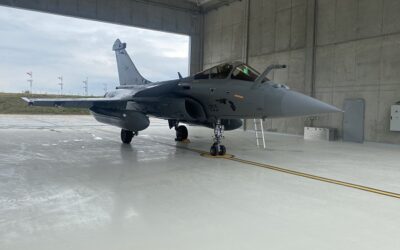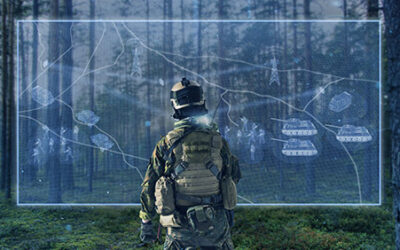MASS showcases innovative approaches to development combat aircraft self-protection
Electronic warfare specialists MASS has revealed details regarding the firm’s latest incarnation of its CounterWorX simulation and modelling tool optimised for countermeasures development in the Radio Frequency (RF), Infrared (IR) and Electro-Optical (EO) domains.
In a white paper published by the firm entitled Building a Capability for Countermeasures Development, the company discusses the importance of Countermeasure (CM) development, and how such challenges can be assisted using simulation and modelling. One of the realities which has been observed by MASS is that CM development can often occur using data which is not necessarily part of a nation’s Electronic Warfare Database (EWDB): Nations will tend to maintain databases on the potential electronic threats that they encounter in peace and war, which will include highly detailed records regarding the transmission characteristics of the airborne, ground-based and naval radars which their armed forces encounter. Such data will be used to inform mission planning and execution regarding the potential threats that their combat aircraft may face, and how these can be avoided of jammed using electronic or physical countermeasures.
Criteria
The paper continues, however, that the scientists and engineers involved in CM development may use a different set of criteria in the design of such products. In essence, they are more concerned with the functions of an emitter’s receiver, processor and guidance functions which will give an indication as to how a radar can be sufficiently jammed, compared to the radar’s transmission characteristics, which will be the focus of the information collected by the EWDB. As the paper notes: “What this means is that there is a risk that the Electronic Warfare Operational Support (EWOS, of which the production of CMs is one part), and the Electronic Support Measure (the functions performed by the EWDB) could evolve and exist as separate streams.” This, the paper continues, can potentially create a dangerous disconnect between the information enshrined in the EWDB and the information used for EWOS: “That is not desirable, because without consistency between the ‘warning’ and the ‘response’, the platform becomes more vulnerable to being hit by a threat weapons system.”
Management System
Such challenges, the company notes, can be overcome by the use of an Electronic Warfare Data Management System (EWDMS). In essence, this database is intended to serve all elements of the prevailing EW mission, which includes the processing of Electronic Intelligence (ELINT), Electronic Support (the processing of ELINT into useful data for mission planning and execution), and Electronic Protection (the development of active and passive countermeasures to protect platforms against electronic threats). MASS continues that such a database should contain an array of information including details of RF, EO and IR threats, to name just three; should not be emitter centric, instead merging such information with data relating to a threat system’s receiving characteristics (see above); should describe emitter vulnerabilities alongside performance; describe CM tactics and techniques and crucially feed this data into sophisticated modelling tools which can then be used for CM design, research and development. Ultimately, the paper states, the task of the EWDMS should be to eliminate stove-piped approaches to EW where ES and EA elements are separate. This, the paper continues will lead to “higher quality and faster (CM) production with a greater common understanding of threat dispositions and parameters.”
Alongside the need to merge the ES and EA elements of a nation’s EW approach, MASS stresses that nations need access to “engineering detail intelligence data on threat weapons systems.” It is one thing to know which ground-based air surveillance radars and surface-to-air missile systems might be arrayed against a nation’s air forces, but quite another to know the technical detail and characteristics of these systems to enable the development of robust CMs which can neutralise these. The problem facing many nations, the paper continues, is that in peacetime, such information is not easily obtainable as one cannot simply visit another country and start collecting detailed information regarding that country’s weapons systems.
Instead, such information is only usually obtainable once a nation is involved in hostilities, by which time it may be too late to meaningfully action such intelligence to develop CMs and, in the worst case, may by then be exacting a cost on the nation’s platforms. MASS’ approach is to use its CounterWorx Discover software which, for example, examines a missile’s physical design so as to make a reliable assessment of the weapon’s performance. Such information could be obtained from a scaled photograph of the weapon, for example, with the missile’s aerodynamics and the position of its control surfaces then being examined to “establish likely performance metrics.” The paper continues that: “Tools such as this give a scientific basis for analysis and modelling, can generate new data, or validate existing data from other sources … What this means is that the CM development process can be started with a minimal data collection, it gives higher quality than ‘best-guess’ or unvalidated open-source data, and importantly it provides nations with a start-up capability which otherwise might be impossible. Additionally, by being aware of specific data gaps, it is easier to focus intelligence collection efforts.”
The Software Approach
So how can the merging of EA and ES data, together with the data developed by examining a weapons system’s design be brought together to aid CM development? The firm’s Threat Vulnerability and CM Development (TVACD) software can be used to this end which includes standard tools, documents and templates which can be used for CM development, and for CM development training. The white paper notes that using this approach to CM development is “process driven” which “instils a necessary sense of discipline and rigour to the activities, and provides a solid basis for change and local optimisation.”
MASS believes that simulation and modelling are becoming increasingly important in CM development by virtue of the increasing complexity of the weapons systems, particularly in the air defence ground environment, which are proliferating around the world: witness the deployment by the Russian armed forces of the Almaz-Antey S-400 Triumf (NATO reporting name SA-21 Growler) SAM system to Syria; two batteries of which are believed to have been deployed to the troubled country as of September 2017. To make matters more complex, NATO air forces have yet to encounter the S-400 in battle, unlike previous marques of Russian SAM which have been encountered during NATO-led interventions in Libya and the Balkans, and during US-led air campaigns in Iraq. The ability to accurately anticipate the performance of weapons systems such as the S-400 could enable the development of CMs in a preventative fashion, rather than waiting until it is too late, and after an aircraft has been lost to such a system, with all of the attendant political controversy that this is almost certain to create in the nation owning that particular aircraft, and the propaganda victory it will hand to the country or armed group responsible for the aircraft’s destruction.
MASS’ approach to modelling allows a wide range of parameters to be evaluated vis-à-vis the weapons system in question, and the CM approach to be taken. This can include the weapon’s ground-based air surveillance and/or fire control/ground controlled interception radar and their transmission/receiving characteristics, along with the SAM itself. While single, or multi-ship engagements involving the weapon can also be simulated, alongside the CMs they may use whether those be radar, electro-optical or infrared based, with engagements being modelled in the land, air and sea domains. The use of simulation software can have downstream financial benefits too, MASS’ paper points out: “It is easier to identify factors having an effect, and therefore it is possible to focus more quickly on potential CMs – which, in turn, reduces the scope of operational trials.” MASS has told MONS that the firm’s countermeasures simulation and modelling software is now in service, supporting countermeasures development in the Asia-Pacific, Europe and the Far East.

























